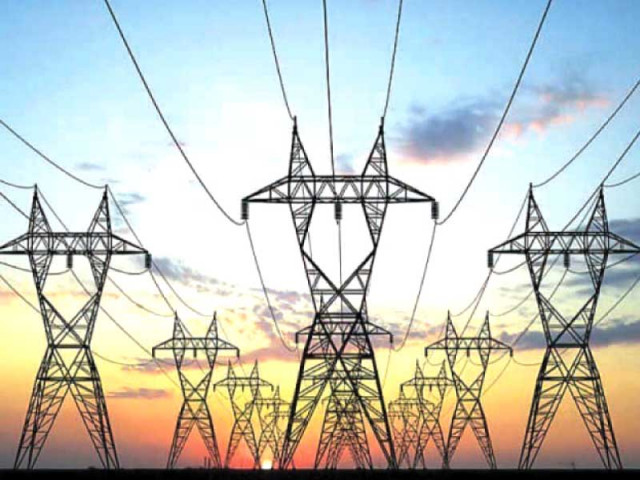Business
Pakistan set to pay Rs100bn Chinese energy debt ahead of PM’s Beijing visit | The Express Tribune

ISLAMABAD:
Pakistan has decided to settle over Rs100 billion in dues owed to Chinese power plants ahead of Prime Minister Shehbaz Sharif’s upcoming visit to Beijing, reducing the country’s outstanding obligations to Chinese producers by nearly one-fourth. This move aims to address one of Beijing’s major concerns.
The Ministry of Finance has issued instructions to release the funds from the power sector subsidies earmarked in this fiscal year’s budget, according to government officials. They said that it is expected the Rs100 billion will be disbursed to the Chinese power producers within a couple of days.
In addition to the Rs100 billion, Rs8 billion is also allocated from the regular budget for the Chinese power producers.
The development comes days before PM Shehbaz’s visit to China, where he is set to attend the Heads of State meeting of the Shanghai Cooperation Organization (SCO) this weekend. The premier is also expected to participate in an investment conference organised by the Pakistan embassy.
Read: PSX opens rollover week on turbulent note
Sources said that the PM had instructed the Finance Ministry to clear the Rs100 billion payments to the Chinese Independent Power Producers by August 25.
As of June this year, the outstanding dues for China-Pakistan Economic Corridor (CPEC) power projects amounted to Rs423 billion. After this payment, the Chinese dues will be reduced by one-fourth, bringing the total to just over Rs300 billion.
There was a slow increase in Chinese outstanding dues last fiscal year, but the dues were still accumulating.
Since 2017, the country has already paid Rs5.1 trillion in energy costs to 18 Chinese power plants, which accounted for 92.3% of the billed amount, including interest. Pakistani authorities believe the actual remaining energy cost is less than Rs300 billion, with the rest attributed to late payment surcharges.
The government is in the process of taking nearly Rs1.3 trillion in fresh loans from local commercial banks to retire the circular debt owed to state-owned power plants, nuclear power plants, privately owned plants, and Chinese plants. However, the deal has not yet been formally concluded.
The Rs423 billion unpaid debts violate the 2015 CPEC Energy Framework Agreement, which mandates the government to fully clear the dues, regardless of whether authorities can recover the amounts from end consumers.
Read More: China’s planned Tibet dam sparks water security fears in India
Along with security concerns, non-fulfillment of CPEC contracts is one of the reasons for slow progress in financial and commercial relations between the two nations.
Under the CPEC Energy Framework Agreement, Pakistan was required to create a revolving fund with 21% of the power invoices to protect Chinese firms from the circular debt crisis.
However, the previous government opened a Pakistan Energy Revolving Account at the State Bank of Pakistan in October 2022, with Rs48 billion in annual allocations. But it limited withdrawals to Rs4 billion per month, leading to the current Rs423 billion debt stock.
Out of the Rs48 billion allocations for this fiscal year, the government has processed Rs8 billion in payments for the July-August period, sources said.
The Rs100 billion will be distributed among the Chinese power producers according to their billing, according to Ministry of Energy officials. They said the majority of this amount will go to the three largest coal-fired power plants.
Also Read: KSE-100 races to 150,000 — too fast, too soon?
Pakistan owed Rs87 billion to the imported coal-fired Sahiwal power plant, which has received Rs1.14 trillion in the past eight years of its operations. The country also owed Rs69 billion to the coal-fired Hub power project, compared to the total claims of Rs834 billion.
The outstanding remaining dues of the coal-fired Port Qasim power plant were Rs85.5 billion, against total bills of over Rs1 trillion. The Thar Coal project dues stood at Rs55.5 billion, with total claims amounting to Rs566 billion.
The government’s energy sector circular debt reduced by over Rs800 billion by June this year, thanks to budgetary injections rather than any real improvement in sector performance.
The reported reduction in Circular Debt (CD) for FY 2024-25 is primarily attributed to a one-time stock payment of Rs801 billion, rather than any sustained operational efficiency gains, according to a report by the Federation of Pakistan Chamber of Commerce and Industry (FPCCI) last week.
The report added that this settlement was financed through fiscal measures, not performance improvements in the power sector.
The FPCCI report also stated that the Rs801 billion was originally earmarked as a direct subsidy for consumers. However, it was instead utilised to reduce the circular debt stock, potentially distorting public perception by overstating the success of reforms and underrepresenting the benefit that consumers should have received.
While the headline suggests a net reduction in circular debt, the inclusion of one-off adjustments—such as Prior Year Adjustments totaling Rs358 billion—masks the actual trajectory, the report concluded.
Excluding the Rs801 billion stock payment and the temporary relief from these adjustments, the circular debt has, in fact, increased by approximately Rs379 billion, it added.
Business
Stock Market Live Updates: Sensex, Nifty Hit Record Highs; Bank Nifty Climbs 60,000 For The First Time

Stock Market News Live Updates: Indian equity benchmarks opened with a strong gap-up on Monday, December 1, touching fresh record highs, buoyed by a sharp acceleration in Q2FY26 GDP growth to a six-quarter peak of 8.2%. Positive cues from Asian markets further lifted investor sentiment.
The BSE Sensex was trading at 85,994, up 288 points or 0.34%, after touching an all-time high of 86,159 in early deals. The Nifty 50 stood at 26,290, higher by 87 points or 0.33%, after scaling a record intraday high of 26,325.8.
Broader markets also saw gains, with the Midcap index rising 0.27% and the Smallcap index advancing 0.52%.
On the sectoral front, the Nifty Bank hit a historic milestone by crossing the 60,000 mark for the first time, gaining 0.4% to touch a fresh peak of 60,114.05.
Meanwhile, the Metal and PSU Bank indices climbed 0.8% each in early trade.
Global cues
Asia-Pacific markets were mostly lower on Monday as traders assessed fresh Chinese manufacturing data and increasingly priced in the likelihood of a US Federal Reserve rate cut later this month.
According to the CME FedWatch Tool, markets are now assigning an 87.4 per cent probability to a rate cut at the Fed’s December 10 meeting.
China’s factory activity unexpectedly slipped back into contraction in November, with the RatingDog China General Manufacturing PMI by S&P Global easing to 49.9, below expectations of 50.5, as weak domestic demand persisted.
Japan’s Nikkei 225 slipped 1.6 per cent, while the broader Topix declined 0.86 per cent. In South Korea, the Kospi dropped 0.30 per cent and Australia’s S&P/ASX 200 was down 0.31 per cent.
US stock futures were steady in early Asian trade after a positive week on Wall Street. On Friday, in a shortened post-Thanksgiving session, the Nasdaq Composite climbed 0.65 per cent to 23,365.69, its fifth consecutive day of gains.
The S&P 500 rose 0.54 per cent to 6,849.09, while the Dow Jones Industrial Average added 289.30 points, or 0.61 per cent, to close at 47,716.42.
Business
South Korea: Online retail giant Coupang hit by massive data leak

Osmond ChiaBusiness reporter
 Getty Images
Getty ImagesSouth Korea’s largest online retailer, Coupang, has apologised for a massive data breach potentially involving nearly 34 million local customer accounts.
The country’s internet authority said that it is investigating the breach and that details from the millions of accounts have likely been exposed.
Coupang is often described as South Korea’s equivalent of Amazon.com. The breach marks the latest in a series of data leaks at major firms in the country, including its telecommunications giant, SK Telecom.
Coupang told the BBC it became aware of the unauthorised access of personal data of about 4,500 customer accounts on 18 November and immediately reported it to the authorities.
But later checks found that some 33.7 million customer accounts – all in South Korea – were likely exposed, said Coupang, adding that the breach is believed to have begun as early as June through a server based overseas.
The exposed data is limited to name, email address, phone number, shipping address and some order histories, Coupang said.
No credit card information or login credentials were leaked. Those details remain securely protected and no action is required from Coupang users at this point, the firm added.
The number of accounts affected by the incident represents more than half of South Korea’s roughly-52 million population.
Coupang, which is founded in South Korea and headquartered in the US, said recently that it had nearly 25 million active users.
Coupang apologised to its customers and warned them to stay alert to scams impersonating the company.
The firm did not give details on who is behind the breach.
South Korean media outlets reported on Sunday that a former Coupang employee from China was suspected of being behind the breach.
The authorities are assessing the scale of the breach as well as whether Coupang had broken any data protection safety rules, South Korea’s Ministry of Science and ICT said in a statement.
“As the breach involves the contact details and addresses of a large number of citizens, the Commission plans to conduct a swift investigation and impose strict sanctions if it finds a violation of the duty to implement safety measures under the Protection Act.”
The incident marks the latest in a series of breaches affecting major South Korean companies this year, despite the country’s reputation for stringent data privacy rules.
SK Telecom, South Korea’s largest mobile operator, was fined nearly $100m (£76m) over a data breach involving more than 20 million subscribers.
In September, Lotte Cards also said the data of nearly three million customers was leaked after a cyber-attack on the credit card firm.
Business
Agency workers covering for Birmingham bin strikers to join picket lines

Agency workers hired to cover Birmingham bin strikers will join them on picket lines on Monday, a union has said.
A rally will be held by Unite The Union at Smithfield Depot on Pershore Street, Birmingham, on Monday morning to mark the first day of strike action by agency refuse workers.
Unite said the Job & Talent agency workers had voted in favour of strike action “over bullying, harassment and the threat of blacklisting at the council’s refuse department two weeks ago”.
The union said the number of agency workers who will join the strike action is “growing daily”.
Strikes by directly-employed bin workers, which have been running since January, could continue beyond May’s local elections.
The directly-employed bin workers voted in favour of extending their industrial action mandate earlier this month.
Unite general secretary Sharon Graham said: “Birmingham council will only resolve this dispute when it stops the appalling treatment of its workforce.
“Agency workers have now joined with directly-employed staff to stand up against the massive injustices done to them.
“Instead of wasting millions more of council taxpayers’ money fighting a dispute it could settle justly for a fraction of the cost, the council needs to return to talks with Unite and put forward a fair deal for all bin workers.
“Strikes will not end until it does.”
-

 Sports1 week ago
Sports1 week agoWATCH: Ronaldo scores spectacular bicycle kick
-

 Entertainment7 days ago
Entertainment7 days agoWelcome to Derry’ episode 5 delivers shocking twist
-

 Politics1 week ago
Politics1 week agoWashington and Kyiv Stress Any Peace Deal Must Fully Respect Ukraine’s Sovereignty
-

 Business1 week ago
Business1 week agoKey economic data and trends that will shape Rachel Reeves’ Budget
-

 Tech6 days ago
Tech6 days agoWake Up—the Best Black Friday Mattress Sales Are Here
-

 Fashion7 days ago
Fashion7 days agoCanada’s Lululemon unveils team Canada kit for Milano Cortina 2026
-

 Tech5 days ago
Tech5 days agoThe Alienware Aurora Gaming Desktop Punches Above Its Weight
-

 Politics1 week ago
Politics1 week ago53,000 Sikhs vote in Ottawa Khalistan Referendum amid Carney-Modi trade talks scrutiny





